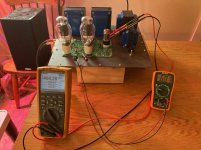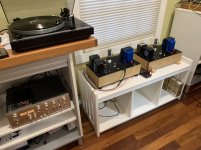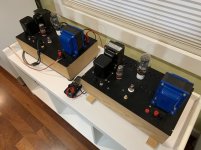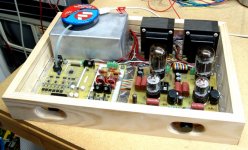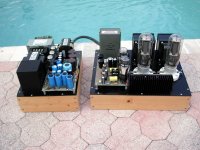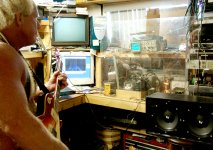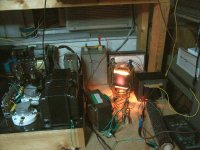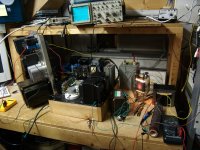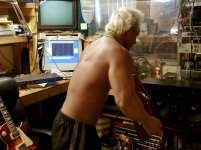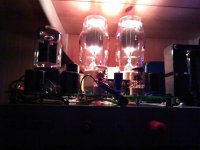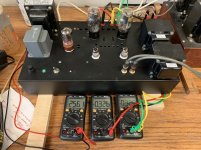It's alive
After waiting four months for the transformers to be wound, I'm excited to say that it's alive and working on the first try (will need to make a better base someday soon - wanted to get it up and alive for a test). Even on the cheap speakers it sounds fantastic!
I was previously worried that B+ would be bit high with my transformer choice. It is, at around 400v with the tubes biases at 65ma. 440v with tubes removed. Wondering if something needs to be done, JJ's datasheet says 450v max on the plates, though the warning to not exceed 400v is still floating around my brain.
Really prefer to stick with a GZ34. Would like to knock about 20-30v off, would reducing C4 be enough? Of possibly there is a better way?
-- Pete
After waiting four months for the transformers to be wound, I'm excited to say that it's alive and working on the first try (will need to make a better base someday soon - wanted to get it up and alive for a test). Even on the cheap speakers it sounds fantastic!
I was previously worried that B+ would be bit high with my transformer choice. It is, at around 400v with the tubes biases at 65ma. 440v with tubes removed. Wondering if something needs to be done, JJ's datasheet says 450v max on the plates, though the warning to not exceed 400v is still floating around my brain.
Really prefer to stick with a GZ34. Would like to knock about 20-30v off, would reducing C4 be enough? Of possibly there is a better way?
-- Pete
Attachments
Congrats Pete, looking good.
I’m also waiting a seriously long time for an Edcor order.
A few options:
- Reduce C4 but that will increase PS ripple which can cause hum.
- add a chassis mount resistor in series with the choke.
- depending on your opt primary, increase the bias of the 300b
I’m also waiting a seriously long time for an Edcor order.
A few options:
- Reduce C4 but that will increase PS ripple which can cause hum.
- add a chassis mount resistor in series with the choke.
- depending on your opt primary, increase the bias of the 300b
(A) 400 Vp should be well within spec on the JJ 300B. Note that TubeLab George runs his 300Bs very near 400Vp.
(B) I agree about keeping the 5AR4, if only for the slow turn-on.
(C) What’s the DCR of the choke? Higher DCR (say 200 ohms) would be easiest way to drop Vp. Hammonds are pretty cheap, and usually in stock.
(D) What’s the Vp if you raise the bias a little, say to 68-70mA?
PS I am using ~12uf C4 (4uF oil + 8uF) and a 10H/163DCR Heathkit choke, and I get ~370 Vp
Haven’t scoped it, but no noise with the ear in the speaker cone..
(B) I agree about keeping the 5AR4, if only for the slow turn-on.
(C) What’s the DCR of the choke? Higher DCR (say 200 ohms) would be easiest way to drop Vp. Hammonds are pretty cheap, and usually in stock.
(D) What’s the Vp if you raise the bias a little, say to 68-70mA?
PS I am using ~12uf C4 (4uF oil + 8uF) and a 10H/163DCR Heathkit choke, and I get ~370 Vp
Haven’t scoped it, but no noise with the ear in the speaker cone..
Last edited:
Thank you both for your quick replies! The DCR comment got my mind in gear, my choke has a really low DCR and that's not helping the cause. As a quick mod for testing, I put in a 75ohm 5w resistor in series with it and dropped 13 volts as calculated (running 175ma, so glad that I went for the 200ma transformer). That should be enough.
Next question, if you don't mind. I noticed that the plate on the 5842 briefly exceeds 300v upon turn-on before quickly settling down to the 175v that I set. The TDS says 200v absolute max. Is this something to worry about (arc-over threat) - or are those ratings continuous state ratings?
Thanks for all the help, what a great group of folks!
-- Pete
Next question, if you don't mind. I noticed that the plate on the 5842 briefly exceeds 300v upon turn-on before quickly settling down to the 175v that I set. The TDS says 200v absolute max. Is this something to worry about (arc-over threat) - or are those ratings continuous state ratings?
Thanks for all the help, what a great group of folks!
-- Pete
Like the "Service Advisor" says at every auto dealership in the land: "They all do that."
No worries mate.
(a) ratings are for continuous use, and
(b) ratings are typically hyper conservative, although some are more hyper than others (USA tubes usually being more conservatively rated than "current" production); e.g. following George's lead, I regularly (and for very long periods) run 6AV5s at DOUBLE the rated plate dissipation
(c) George runs 45s at ~325Vp in a TSE. 'Nuff said.
[Good On Ya for leaving a meter on the 5842 plate. In my "Flexiamp" Simple 45 clone, I never bothered to look at the Vp across the 5842 when I changed power tubes between 45/46/2A3/300B and twiddled the knobs on the regulated power supply; I'm SURE I exceeded 200V for long periods. The damned things are RIDICULOUSLY expensive nowadays, but they DO seem pretty tolerant of abuse.]
PS I have discovered that one of my NEW EH "Gold" 300Bs would periodically not hold bias (90,100,120,150mA...that'll suck The Boys right back up your inguinal canals I'll tell ya'), so I'm returning it. I suspect that I have a filament sucking itself into the grid, and the DC fils probably isn't helping... so I just ordered a pair of JJs for myself to try-out the supposed improved filament structure.
On that note, has anybody tried the JJ 2A3-40, which is essentially the JJ 300B guts with a center tap on the filament (2x 2.5V fils instead of 1x 5V)?
Downside is that they seem to cost the same as the 300Bs (which seems reasonable).
Upside is that they are 40W Single Plate 2A3s(!). I am sorely tempted, as I have some 3K SE OPTs which would work good with those puppies, but I'm not sure that there would be any (sonic) difference between the 40W 2A3 and the 300Bs.
No worries mate.
(a) ratings are for continuous use, and
(b) ratings are typically hyper conservative, although some are more hyper than others (USA tubes usually being more conservatively rated than "current" production); e.g. following George's lead, I regularly (and for very long periods) run 6AV5s at DOUBLE the rated plate dissipation
(c) George runs 45s at ~325Vp in a TSE. 'Nuff said.
[Good On Ya for leaving a meter on the 5842 plate. In my "Flexiamp" Simple 45 clone, I never bothered to look at the Vp across the 5842 when I changed power tubes between 45/46/2A3/300B and twiddled the knobs on the regulated power supply; I'm SURE I exceeded 200V for long periods. The damned things are RIDICULOUSLY expensive nowadays, but they DO seem pretty tolerant of abuse.]
PS I have discovered that one of my NEW EH "Gold" 300Bs would periodically not hold bias (90,100,120,150mA...that'll suck The Boys right back up your inguinal canals I'll tell ya'), so I'm returning it. I suspect that I have a filament sucking itself into the grid, and the DC fils probably isn't helping... so I just ordered a pair of JJs for myself to try-out the supposed improved filament structure.
On that note, has anybody tried the JJ 2A3-40, which is essentially the JJ 300B guts with a center tap on the filament (2x 2.5V fils instead of 1x 5V)?
Downside is that they seem to cost the same as the 300Bs (which seems reasonable).
Upside is that they are 40W Single Plate 2A3s(!). I am sorely tempted, as I have some 3K SE OPTs which would work good with those puppies, but I'm not sure that there would be any (sonic) difference between the 40W 2A3 and the 300Bs.
Last edited:
My TSE-II_2A3 is coming along. I've got a 300-0-300 mains and Edcor OPT. The 2A3 is a 1947 RCA VT95 I'm saving up for this build.
Rectified voltage (GZ34) will be anywhere between 320-340v. Can I run the tube with a lower current and this voltage?
Rectified voltage (GZ34) will be anywhere between 320-340v. Can I run the tube with a lower current and this voltage?
Last edited:
Thanks for the info Hareynolds. Your advice put my mind at ease about the voltages. Sorry to hear that your EH tube was defective, good thing you were able to catch that bias shift before it was too late!
I'll be curious to hear your thoughts on the JJs once you've listened to them for a bit. My initial impression is very good - as this is my first 300b amp, I have nothing to compare them to, but they sound better than the other 4 tube amp that I have built.
I'll be curious to hear your thoughts on the JJs once you've listened to them for a bit. My initial impression is very good - as this is my first 300b amp, I have nothing to compare them to, but they sound better than the other 4 tube amp that I have built.
TSE-II Monoblocks
The monoblocks are working REALLY well, after struggling with the wonky (new) EH 300B and thermal “issues” (ie this is a HOT amp w/ all that sand under there).
[Everybody’s heard of the “Dunker Ratio” (created by Norwegian wild-man Thomas Dunker) that expresses weight efficiency, ie KG/watts. Perhaps we need a “TubeLab Ratio” that’s BTUs/Watt.]
(A) like lots of fixed bias guitar amps, there are two bias test jacks behind the OPT, connected to either side of the 10 ohm plate resistor (R18 & R29), along with a 10-turn Bourns 100K pot wired into the bias pot pads (R12 & R23).
I REALLY dislike adjusting trimpots in a thicket of components at 400 volts; a Man’s Gotta Know His Limitations. I discovered the Bourns multi-turn pots when fooling with regulated power supplies; highly recommended. A little expensive ($12?) but will adjust to the third sig figure, ie tens of micro amps.
(B) changed R6 from 10K 6.5W to a pair of 5K 5W cement wirewounds in series, arranged in an inverted vee; with increased surface area and mounting away from the board, seems to run a little cooler.
(C) The positive MOSFET supply resistor (R36) is a 10K 25W finned wire wound mounted off the board to the top plate. Below 65mA this runs quite cool, but in any case is much better off the board.
(D) changed R5 to 2W; the specified 1W was running pretty hot.
(E) Since there’s only one 5842 per monoblocks, R3 is changed to a 7 ohm 5W wire wound to get the fils voltage just below 6.3V.
I made monoblocks because this is primarily a MONO system (everybody knows that Stereo is a scam), but also because I had the 6K7VG PSTs and Heathkit chokes in stock. The 6K7s actually run very cool at HALF their rated amperage, so there’s that.
The left amp has an experimental baseplate with a 120v muffin fan and speed control. Not noticeable, since I’m next to the kitchen, and the speakers are in the next room. It stays very cool, but it isn’t perfectly silent even at low RPMs; the “naturally aspirated” one runs much hotter of course, but the bias is now rock-steady.
Not surprisingly, the retained heat seems to go up exponentially above about 65 mA, which is the nature of the curve...
The 25W “C” series EDCOR OPTs seem to be quite good; certainly the best bass I’ve ever heard from an SE amp, which agrees with George’s findings. Probably overkill for 45s, but really really good matched to 300Bs. The clarity of an SE amp, with the bass of a small P-P amp, say a Dynaco EL84.
The monoblocks are working REALLY well, after struggling with the wonky (new) EH 300B and thermal “issues” (ie this is a HOT amp w/ all that sand under there).
[Everybody’s heard of the “Dunker Ratio” (created by Norwegian wild-man Thomas Dunker) that expresses weight efficiency, ie KG/watts. Perhaps we need a “TubeLab Ratio” that’s BTUs/Watt.]
(A) like lots of fixed bias guitar amps, there are two bias test jacks behind the OPT, connected to either side of the 10 ohm plate resistor (R18 & R29), along with a 10-turn Bourns 100K pot wired into the bias pot pads (R12 & R23).
I REALLY dislike adjusting trimpots in a thicket of components at 400 volts; a Man’s Gotta Know His Limitations. I discovered the Bourns multi-turn pots when fooling with regulated power supplies; highly recommended. A little expensive ($12?) but will adjust to the third sig figure, ie tens of micro amps.
(B) changed R6 from 10K 6.5W to a pair of 5K 5W cement wirewounds in series, arranged in an inverted vee; with increased surface area and mounting away from the board, seems to run a little cooler.
(C) The positive MOSFET supply resistor (R36) is a 10K 25W finned wire wound mounted off the board to the top plate. Below 65mA this runs quite cool, but in any case is much better off the board.
(D) changed R5 to 2W; the specified 1W was running pretty hot.
(E) Since there’s only one 5842 per monoblocks, R3 is changed to a 7 ohm 5W wire wound to get the fils voltage just below 6.3V.
I made monoblocks because this is primarily a MONO system (everybody knows that Stereo is a scam), but also because I had the 6K7VG PSTs and Heathkit chokes in stock. The 6K7s actually run very cool at HALF their rated amperage, so there’s that.
The left amp has an experimental baseplate with a 120v muffin fan and speed control. Not noticeable, since I’m next to the kitchen, and the speakers are in the next room. It stays very cool, but it isn’t perfectly silent even at low RPMs; the “naturally aspirated” one runs much hotter of course, but the bias is now rock-steady.
Not surprisingly, the retained heat seems to go up exponentially above about 65 mA, which is the nature of the curve...
The 25W “C” series EDCOR OPTs seem to be quite good; certainly the best bass I’ve ever heard from an SE amp, which agrees with George’s findings. Probably overkill for 45s, but really really good matched to 300Bs. The clarity of an SE amp, with the bass of a small P-P amp, say a Dynaco EL84.
Attachments
Last edited:
No SE tube amp will ever win an efficiency contest, not even the class H creation I designed for a magazine contest over 10 years ago. The amp design won a prize in the Microchip design contest which resulted in a magazine publication in 2009. It is no longer available on the magazine's web site, so I am including it here. Due to the high efficiency afforded by the DSP power supply I could get 30 watts out of a single 6AS7 without violating it's specs. The tube stays in class A, but lives with less than 100 volts on its plate keeping dissipation to a minimum.
The absolute worst energy waster of any completed tube amp that I ever made has to be the 845 SE. It burns over 500 watts to make 30 WPC. Note that the driver board is the second TSE prototype board ever made. Three of those hand made boards were done, and suitably abused before getting commercial boards produced......yes, I played guitar through a 300B TSE too.
The most heat pumped into a 10 X 10 foot room award goes to the deadliest amp I ever created. It was a one time experiment that only existed for a week. 200 watts of SE guitar amp racket furnished by an 833A running in the red glow mode on 1500 volts from the power supply out of an old Motorola radio transmitter. There is 550 watts of heat coming out of that tube at idle (1500 volts @300 mA plate + 10 volts @ 10A filament). You can feel the IR from across the room, and even with an extra room AC unit on full cold, I got about 20 minutes playing time before I had to leave the room. Being drenched in sweat near that bench of death isn't a good thing. Note the carefully crafted tube socket, and the yellow high voltage lead going to the 7500 volt plate bypass cap.....yeah, Radio Shack's finest......Don't do this at home guys, I'm a trained idiot!
Really, for all but a few pictures there was a 1/4 inch thick sheet of plexiglass between me and this thing. There was also a fire extinguisher at my feet at all times. In a week of serious noise making the only "events" were a tripped bench breaker twice. If I timed my guitar playing just right I could excite a resonance in that power supply at about 2 Hz. I could get the tube glow pulsing and the plate current meter needle swinging. If I continued this for a few seconds I could get the room lights blinking, followed by darkness.
There was a pirate radio broadcaster that lived two blocks away with the studio in his garage. He ran a play along guitar lesson show on Friday nights. I opened up the window and played along.....I got some free airplay that night.
The modern PC, TV and monitor will clue you into the time period.
The absolute worst energy waster of any completed tube amp that I ever made has to be the 845 SE. It burns over 500 watts to make 30 WPC. Note that the driver board is the second TSE prototype board ever made. Three of those hand made boards were done, and suitably abused before getting commercial boards produced......yes, I played guitar through a 300B TSE too.
The most heat pumped into a 10 X 10 foot room award goes to the deadliest amp I ever created. It was a one time experiment that only existed for a week. 200 watts of SE guitar amp racket furnished by an 833A running in the red glow mode on 1500 volts from the power supply out of an old Motorola radio transmitter. There is 550 watts of heat coming out of that tube at idle (1500 volts @300 mA plate + 10 volts @ 10A filament). You can feel the IR from across the room, and even with an extra room AC unit on full cold, I got about 20 minutes playing time before I had to leave the room. Being drenched in sweat near that bench of death isn't a good thing. Note the carefully crafted tube socket, and the yellow high voltage lead going to the 7500 volt plate bypass cap.....yeah, Radio Shack's finest......Don't do this at home guys, I'm a trained idiot!
Really, for all but a few pictures there was a 1/4 inch thick sheet of plexiglass between me and this thing. There was also a fire extinguisher at my feet at all times. In a week of serious noise making the only "events" were a tripped bench breaker twice. If I timed my guitar playing just right I could excite a resonance in that power supply at about 2 Hz. I could get the tube glow pulsing and the plate current meter needle swinging. If I continued this for a few seconds I could get the room lights blinking, followed by darkness.
There was a pirate radio broadcaster that lived two blocks away with the studio in his garage. He ran a play along guitar lesson show on Friday nights. I opened up the window and played along.....I got some free airplay that night.
The modern PC, TV and monitor will clue you into the time period.
Attachments
Last edited:
I've seen those pics of the "rig of death" many times, and they never fail to amaze me. Those tube sockets are quite versatile, and tough, too (I adapted one for use just last week to remove a finish nail from some trim carpentry). You never have to worry about the contacts loosening with use, either. Their biggest drawback is that the PC Board mount variety is difficult to find, as are those with gold-plated contacts. 

i d looooove a BRIGHT 805/845/811/gm70 amp, but it would be rather dificult for me, it would require dificult and expensive parts etc..
If you want a Thoriated Tungsten experience you should go for it. The parts and complexity are no greater than what you'd do for a 2A3 honestly.
This is sridhar ganti's 811A A2 amp for along time ago. I've build a similar one and it sounds fantastic. Further, the 811A in A2 really does what TSE board was designed for.... Looking at Ganti's schematic and fitting it to TSE, its real easy:
The 7788 and T1 go away. You use a front end tube on the TSE with a gain of 20 or so. The 12AU7, 6CG7, any of that dude - seriously its easy.
Next, the 6W6GT and the T2 go away because - of the MOSFET.
You'll need to stand the MOSFET up to +22V on the grid at idle. You'll get a good 9W out of this.
You can use a Hammond 1628SE, 1629SE or an Edcor TX. Gapped for 100mA or so of idle current. You will love it, really you will!
http://www.one-electron.com/Projects/Randall/ganti_811A.pdf
The "Thoriated Tungsten Experience"
Invocation: "lead us not into temptation, but deliver us from evil..." Oops, too late...
Has anybody actually BUILT a TSE using 811-A output tubes?
I ask only because:
(a) have one more TSE-II board (after I finish the 45 version)
(b) have a few PMillett Filament Power Supplies (the ones with the common-mode chokes, nice...)
(c) have a multitude of lowish Mu drivers.
(d) have a couple of sets of random SE OPTs (although I would order a pair of 25W EDCOR CXSE opts if warranted)
(e) I have an old chassis with a big horizontal Stancor PST, a big choke of suspicious parentage, and a rectifier socket just sitting there. IIRC this set-up makes ~450V at something around 200mA.
I'm thinking that an 811A SE using the Power Drive topology would be best built using point-to-point, but with a proto board for driver CCS/coupling cap/MOSFET and associated resistors. Sort of a "coupling board" if you will.
BTW, recently discovered the ADAfruit Perma-Proto boards, which look like my cup of tea: Breadboards & Protoboards Products Category on Adafruit Industries
Besides, P-to-P wiring also opens-up the field to antique drivers (e.g. 56/76) and I have more of those than any one man ought to have (ignoring for a second the awkwardness yet another DC filament supply)
What says y'all?
JRD, did you ever build your 811A with 56 driver?? Just curious.
Invocation: "lead us not into temptation, but deliver us from evil..." Oops, too late...
Has anybody actually BUILT a TSE using 811-A output tubes?
I ask only because:
(a) have one more TSE-II board (after I finish the 45 version)
(b) have a few PMillett Filament Power Supplies (the ones with the common-mode chokes, nice...)
(c) have a multitude of lowish Mu drivers.
(d) have a couple of sets of random SE OPTs (although I would order a pair of 25W EDCOR CXSE opts if warranted)
(e) I have an old chassis with a big horizontal Stancor PST, a big choke of suspicious parentage, and a rectifier socket just sitting there. IIRC this set-up makes ~450V at something around 200mA.
I'm thinking that an 811A SE using the Power Drive topology would be best built using point-to-point, but with a proto board for driver CCS/coupling cap/MOSFET and associated resistors. Sort of a "coupling board" if you will.
BTW, recently discovered the ADAfruit Perma-Proto boards, which look like my cup of tea: Breadboards & Protoboards Products Category on Adafruit Industries
Besides, P-to-P wiring also opens-up the field to antique drivers (e.g. 56/76) and I have more of those than any one man ought to have (ignoring for a second the awkwardness yet another DC filament supply)
What says y'all?
JRD, did you ever build your 811A with 56 driver?? Just curious.
I built one using SV811 - 10.
Really liked it.
There is a thread / pics of it here somewhere in the subforum. Can't recall if it is in it's own thread, or in the 801A thread.
edit:
Here you go fellas:
801A in Tubelab Single Ended?
Really liked it.
There is a thread / pics of it here somewhere in the subforum. Can't recall if it is in it's own thread, or in the 801A thread.
edit:
Here you go fellas:
801A in Tubelab Single Ended?
Attachments
Last edited:
Svetlana got too $$ for my blood
That's the Svetlana TopCapLess 811, n'est-ce pas?
I should have laid in a stock of original (St. Petersburg) tubes while I had the chance, but IIRC I was paying for a private college at the time.
Me: How much did Catie's college cost?
Chief Cook & Bottle-Washer: You don't want to know.
Me: How much did Catie's Wedding cost?
CC&BW: We've already HAD this discussion.
Of course, I see that there are now Shuggie 811As, so I could try that.
The Topcap would mean that it is exiled to the shop, but I could live with that.
(a) What driver and driver current setting?
(b) What MOSFET voltage(s)?
(c) What B+? I assume 450-500VDC
(d) What OPT impedance? Looks liek 5K to me, but I see folks using much lower...
(e) DC filaments? Separate supply?
That's the Svetlana TopCapLess 811, n'est-ce pas?
I should have laid in a stock of original (St. Petersburg) tubes while I had the chance, but IIRC I was paying for a private college at the time.
Me: How much did Catie's college cost?
Chief Cook & Bottle-Washer: You don't want to know.
Me: How much did Catie's Wedding cost?
CC&BW: We've already HAD this discussion.
Of course, I see that there are now Shuggie 811As, so I could try that.
The Topcap would mean that it is exiled to the shop, but I could live with that.
(a) What driver and driver current setting?
(b) What MOSFET voltage(s)?
(c) What B+? I assume 450-500VDC
(d) What OPT impedance? Looks liek 5K to me, but I see folks using much lower...
(e) DC filaments? Separate supply?
The tubes were actually made by Ryazan, and marketed by the real Svetlana Electron devices.
They were available in mu of 3, 10, 30 (?) and maybe 160 like the RF versions. The SV572 were also available in the same mu. The ones shown in my pics are mu 10. Needless to say the CCS loaded 5842 and power drive can drive the ever loving snot out of a mu 10 tube.
I'll spare you the agony of looking at a picture of a tub of NOS 811A and 572B, both U.S. and Russkie versions. But if it makes you feel any better, after putting two kids through college, I am back on the treadmill with a third harmonic ...
Operating points ( some, anyway ) should be in the thread. I never fully explored the SV811 before I tore the amp down for overhaul. I just haven't got back around to it - I was distracted by the DHT SSE thing, and for the last few years a very simple RF project that has turned out to be a bigger / longer / seemingly never ending learning curve than I anticipated.
They were available in mu of 3, 10, 30 (?) and maybe 160 like the RF versions. The SV572 were also available in the same mu. The ones shown in my pics are mu 10. Needless to say the CCS loaded 5842 and power drive can drive the ever loving snot out of a mu 10 tube.
I'll spare you the agony of looking at a picture of a tub of NOS 811A and 572B, both U.S. and Russkie versions. But if it makes you feel any better, after putting two kids through college, I am back on the treadmill with a third harmonic ...
Operating points ( some, anyway ) should be in the thread. I never fully explored the SV811 before I tore the amp down for overhaul. I just haven't got back around to it - I was distracted by the DHT SSE thing, and for the last few years a very simple RF project that has turned out to be a bigger / longer / seemingly never ending learning curve than I anticipated.
Long ago in a galaxy far away.......in a time before Tubelab existed I built an SE amp using 811A tubes. PowerDrive didn't exist yet, so I used a 6V6 as a cathode follower to drive the grid of the 811A. The amp worked, made a few watts of power (don't remember exactly how many) at a reasonable distortion number, but sounded much like the kid across the street's boom boom car without the license plate rattle.
The 811A has a very high Mu, 160 if I remember right. That will give it a very high plate resistance that results in a damping factor somewhere between zero and nuthin. This may work on some speakers with some music, but I didn't like it. I wound up selling all my 811A's to a ham radio operator for his RF linear amp.
The 811A will plug in to the TSE or TSE-II board. I know that the regulator in the old TSE will fry if you try to get 6.3 volts out of it. I did have some 809's running in a TSE but the old Sharp regulator is only good to 7 volts input. The 809 amp wound up running without a regulator at all.
Note that the SV811-10 is NOT an 811A. It has a loose wound grid for a Mu of 10 and it needs a negative grid voltage. The 811A requires zero or a slightly positive grid voltage at the plate voltages seen in most DIY audio stuff (under 500 volts).
Fast forward to about 10 years ago and I was experimenting with the beam regulator triodes (6HV5, 6HS5....) these can dissipate 30 to 40 watts, have a Mu of 2000! and a Gm of 65000!! They will oscillate at RF while they are still in the box if looked at funny, but I was attempting to make the minimum parts audio amp.
The audio path was real simple, a driver transformer, and output transformer, the tube and a power supply. I drove it directly from the headphone output of a Sony Discman, and it made about 2 watts on 600 volts of B+. The "below negative" damping factor made the 811A amp sound good. I still have about 25 of those tubes on a shelf, one of the few tubes that I have not yet conquered.
The high Mu makes these tube easy to drive, so you could throw away some gain with GNFB to fix the booming bass, but why?
There is no reason why the UNSET technology won't work with triodes, and could make a fair high Mu triode into a better low Mu triode, but I haven't tried it yet.
The 811A has a very high Mu, 160 if I remember right. That will give it a very high plate resistance that results in a damping factor somewhere between zero and nuthin. This may work on some speakers with some music, but I didn't like it. I wound up selling all my 811A's to a ham radio operator for his RF linear amp.
The 811A will plug in to the TSE or TSE-II board. I know that the regulator in the old TSE will fry if you try to get 6.3 volts out of it. I did have some 809's running in a TSE but the old Sharp regulator is only good to 7 volts input. The 809 amp wound up running without a regulator at all.
Note that the SV811-10 is NOT an 811A. It has a loose wound grid for a Mu of 10 and it needs a negative grid voltage. The 811A requires zero or a slightly positive grid voltage at the plate voltages seen in most DIY audio stuff (under 500 volts).
Fast forward to about 10 years ago and I was experimenting with the beam regulator triodes (6HV5, 6HS5....) these can dissipate 30 to 40 watts, have a Mu of 2000! and a Gm of 65000!! They will oscillate at RF while they are still in the box if looked at funny, but I was attempting to make the minimum parts audio amp.
The audio path was real simple, a driver transformer, and output transformer, the tube and a power supply. I drove it directly from the headphone output of a Sony Discman, and it made about 2 watts on 600 volts of B+. The "below negative" damping factor made the 811A amp sound good. I still have about 25 of those tubes on a shelf, one of the few tubes that I have not yet conquered.
The high Mu makes these tube easy to drive, so you could throw away some gain with GNFB to fix the booming bass, but why?
There is no reason why the UNSET technology won't work with triodes, and could make a fair high Mu triode into a better low Mu triode, but I haven't tried it yet.
The low mu audio variants are still relatively easy to source, look just as spectacular in operation, and work so darn well with the TSE circuit, it's hard for me to see a reason to do it the ( really ) hard way by going with the high mu RF tubes.
The SV572-160 are often dirt cheap at hamfests. I grabbed a NOS pair for $50 USD the last time I went to HamComm. Note that Svetlana gives a reasonably obtainable operating point for single ended A2 operation with these tubes. So when the UNSET boards are available, this might be an interesting experiment.
I've attached the data sheet for the SV572-160 and a Svetlana tech note on the use of their big triodes for audio. They recommend 20 dB negative feedback if the RF triodes are used as audio amps. That magnitude of NFB would probably put most audiophiles into cardiac arrest.
... The high Mu makes these tube easy to drive, so you could throw away some gain with GNFB to fix the booming bass, but why?
There is no reason why the UNSET technology won't work with triodes, and could make a fair high Mu triode into a better low Mu triode, but I haven't tried it yet.
The SV572-160 are often dirt cheap at hamfests. I grabbed a NOS pair for $50 USD the last time I went to HamComm. Note that Svetlana gives a reasonably obtainable operating point for single ended A2 operation with these tubes. So when the UNSET boards are available, this might be an interesting experiment.
I've attached the data sheet for the SV572-160 and a Svetlana tech note on the use of their big triodes for audio. They recommend 20 dB negative feedback if the RF triodes are used as audio amps. That magnitude of NFB would probably put most audiophiles into cardiac arrest.
Attachments
TSE-II Numero Tres
Here’s TSE-II #3 with 45s
I only have the TWO, so I’m sneaking-up on the operating point.
PST is Allied 6K56
Choke is from an HP something-or-other (audio oscillator? Reg P/S?); most important (beyond the cast aluminum frame!), it has high DCR, about 265 ohms IIRC.
C1 is a 4uF Russkie Oil & Paper, LITERALLY a pinko capacitor. As soon as we’ve run for a hour or so, I’ll add 12-16uF to get B+ up a bit.
OPTs are Transcendar 5K:8 ohms from ancient stock.
Sound is exactly as expected with these OPTs: spectacular detail, “airy”, blah-blah. At this B+, it’s a little “thin” compared to the 300B version, but that’s to be expected. “Girl with Guitar” music is of course spectacular. Joni is breathing down my neck; wish she had done that 4 decades ago….
One tube is a little weak & wonky: prob’ly need to scrounge some backups…
The BIG question is whether bigger/badder/“bassier” OPTs are justified (and will they FIT). We’ll see when the B+ gets up where it should be.
Here’s TSE-II #3 with 45s
I only have the TWO, so I’m sneaking-up on the operating point.
PST is Allied 6K56
Choke is from an HP something-or-other (audio oscillator? Reg P/S?); most important (beyond the cast aluminum frame!), it has high DCR, about 265 ohms IIRC.
C1 is a 4uF Russkie Oil & Paper, LITERALLY a pinko capacitor. As soon as we’ve run for a hour or so, I’ll add 12-16uF to get B+ up a bit.
OPTs are Transcendar 5K:8 ohms from ancient stock.
Sound is exactly as expected with these OPTs: spectacular detail, “airy”, blah-blah. At this B+, it’s a little “thin” compared to the 300B version, but that’s to be expected. “Girl with Guitar” music is of course spectacular. Joni is breathing down my neck; wish she had done that 4 decades ago….
One tube is a little weak & wonky: prob’ly need to scrounge some backups…
The BIG question is whether bigger/badder/“bassier” OPTs are justified (and will they FIT). We’ll see when the B+ gets up where it should be.
Attachments
Addendum: I meant C4 of course, not C1.
Added 16uF across C4 for measured total of ~19uF.
Raised B+ to ~270vdc.
Definitely tightened it up & increased bass pretty substantially.
I’m across the shop listening to Chuck E’s In Love; drum kit is pretty clear and crisp, including Tom-Tom and bass.
I’ll leave it here for a while. 45s are just precious enuf that if I want to push the operating envelope, I’ll do it to current-production tubes…
Added 16uF across C4 for measured total of ~19uF.
Raised B+ to ~270vdc.
Definitely tightened it up & increased bass pretty substantially.
I’m across the shop listening to Chuck E’s In Love; drum kit is pretty clear and crisp, including Tom-Tom and bass.
I’ll leave it here for a while. 45s are just precious enuf that if I want to push the operating envelope, I’ll do it to current-production tubes…
- Home
- More Vendors...
- Tubelab
- After a 14 year run, the TSE must DIE!
